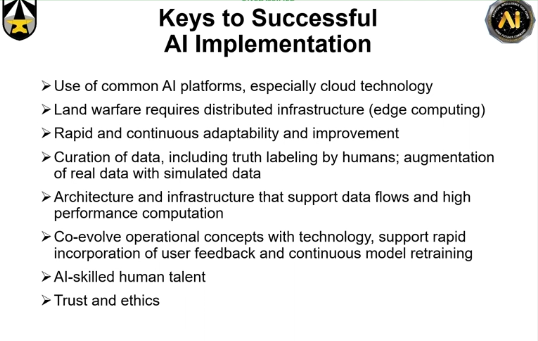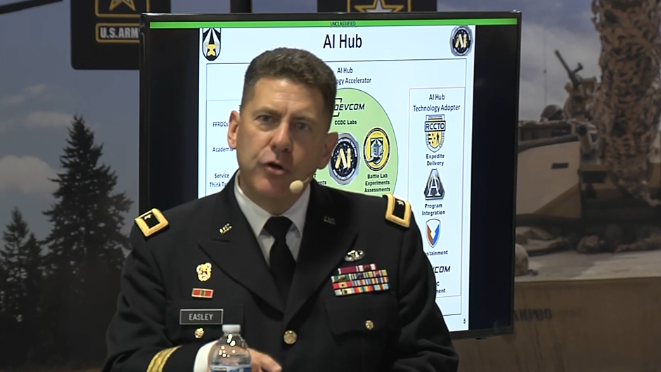AI “needs to span every battlefield system that we have, from our maneuver systems for our fire control systems to our sustainment systems to our soldier systems to our human resource systems and our enterprise systems.”
Brig. Gen. Matthew Easley, Director of the Army AI Task Force (AAITF), made these remarks at the 2019 AUSA Warriors Corner, which runs from October 14-16.
“We need to be able to create an AI infrastructure for the Army” — Brig. Gen. Matthew Easley
The US Army is looking to integrate AI into every facet of its operations.
Read More: Unclassified: DoD cloud strategy to focus on AI adoption
“We see AI as an enabling technology for all Army modernization priorities — from future vertical lift to long range precision fires to soldier lethality,” said Easley.
In order for the US Army to get fully up-to-date with the latest technology, the AAITF is working on four key projects that will expand into 2020:
- AI Requirements and Capabilities
- Intelligence Support to Operations
- Predictive Maintenance (PMx)
- Mobile Cooperative and Autonomous Sensors (MCAS)
- Talent Management (TM)
- Support to CFTs and other Army agencies
- Multi-Domain Operations (MDO) and Mission Command
- Evolve an Army AI Infrastructure
- Establish the AI Hub
- Develop tools for a replicable AI ecosystem
- Extend Joint AI Center (JAIC) capabilities to Army
- Army Wide AI / Data Culture
- AI education for the workforce
- Ethical use of AI
- Set the Conditions for Army AI
- Identify policies that impede deployment of AI technologies
- Track AI spending across the Army
Updating systems can be a chaotic process when there is no uniform code.
“We can’t have 50 different AI solutions across the Army,” said Easley, adding, “we need to make it easier for our soldiers to do AI regardless of what business application they’re in. And this is why we’re developing an AI ecosystem for use within the Army.
“Doing this at scale is going to be a challenge for the Army because if you think about the number of platforms we have in the Army, it is incomprehensible at times.”
Read More: DoD needs ‘more of a startup mentality when looking at tech like AI’: Defense CIO
Easley stressed the need for the use of common AI platforms that can all be accessed rapidly, especially on the cloud.

Army AI Implementation slide
“We need to create an Army AI data culture”
The need to update outdated systems is great, but the Army wants that these updates be as seamless as possible.
“We need to develop our AI systems so that they are as seamless as an update on your smart phone,” said Easley.
His words came on the same day that the Defense Advanced Research Projects Agency (DARPA) launched the Assured Micropatching (AMP) program to do just what Easley described.
“AMP aims to develop tools and methodologies for analyzing, modifying, and fixing legacy software in binary form with the assistance of assured, targeted “micropatches.” Micropatches are small patches that change the binary as little as possible in order to achieve an intended objective while also minimizing the potential side effects of the fix,” according to the project description.
“We need to develop our AI systems so that they are as seamless as an update on your smart phone”
According to Easley, the Army is currently focusing on four initial AI projects:
- Mobile Cooperative and Autonomous Sensors
- Through a network of air and ground-based sensors and systems, capable of operation in both a local network and integrated as a node in a greater architecture, detects and tracks threats, predicts threat behavior, and optimizes target engagement priorities while conducting tactical maneuver.
- Predictive Maintenance (PMx)
- Predictive component failure before it occurs so that remedial actions can be folded into the maintenance schedule, reducing unscheduled downtime and the probability of cascading failures that increase cost.
- Talent Management
- Talent management seeks to use artificial intelligence to optimize management of Army personnel, both in the identification of talent and job performance requirements, and through the use of advanced analytic methods and models to inform career management throughout the Army’s Talent Marketplace.
- Intelligence Support to Operations
- Augmenting Military Intelligence and Operations (Intel/Ops) with Artificial Intelligence Capabilities to enable Multi-Domain Operations through automation of IPB, AI-driven I&W and targeting, and AI-ready sensing.
The US Army Artificial Intelligence Task Force leads, integrates, and synchronizes the Army AI strategy and implementation plan, key AI development efforts, and sets the foundations for the operationalizing AI withing the ARmy Future Force Modernization Enterprise.










